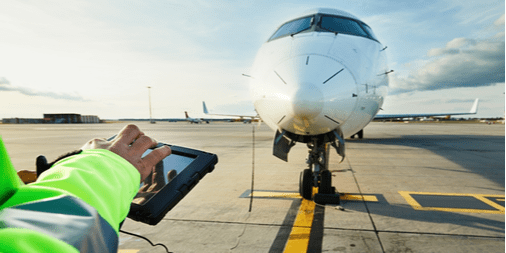Innovation above the clouds
Aerospace engineering is concerned with the development of everything above us, whether that be how to get from one country to another or one planet to another. As the second largest sector in Europe and third globally, the UK aerospace sector is a major contributor to the country’s GDP generating £35bn in 2017 [1].
For decades we have mused over the term “Space – the final frontier” but recent developments within the sector, driven by the desire to know what really exists beyond our hemisphere, has seen the aerospace industry grow faster than ever, putting an answer to that question in our reach.
With its own dedicated area and forum at this year’s Advanced Engineering show, the Aero Engineering zone proved to be one of the most popular areas across the two days. Exhibitors showcased pioneering innovations which had been developed to address significant challenges within the sector.
Speaking at the event, Sameer Savani, Head of Innovation and Engineering at ADS, discussed the barriers blocking potential progress in aerospace, and the innovations needed to take the sector into the future.
“An existential crisis”
Aviation currently accounts for around 2% of the planet’s carbon emissions and, without drastic changes, this figure is going to continue rising. With people around the world becoming ever more environmentally conscious, and the concept of ‘flight shaming’ spreading widely, Sameer believes “emissions are an existential crisis for the industry”.
However, through the use of technology, aerospace engineers have worked to ‘decouple’ the sector’s growth with an increasing negative impact on the planet. This means that aviation should be able to continue expanding, as it is expected to do, without an equal rise in emissions.
One way this is being achieved is through electrification. And, while it may be some time before commercial flights are fully powered by electricity, the concepts of battery-powered and hybrid aircraft are fully in development, which should help to reduce the carbon footprint.
The UK is the first major economy in the world to commit to pass laws to end its contribution to global warming by 2050, however to achieve this, aviation is going to have to play a big part, and electrification could be crucial to this.

“Slow to digitalise”
Sameer discussed how the aerospace industry is widely considered to be behind other sectors when it comes to adopting digital. He says that companies need a lot of help, as it can be difficult to incorporate digital methods and processes into established, traditional business models.
One of the major barriers to aerospace’s digitalisation is cybersecurity. It is reported that the manufacturing sector is the fifth most targeted for cyber-attacks with more than 60% of UK manufacturers reported as being victims of cybercrime in 2019.[2] Despite this the sector remains one of the least protected sectors, as many companies are reluctant to fully commit to digital.
Digital is the future of aerospace and there needs to be greater awareness and confidence in such practices, especially among senior staff members. In his presentation Sameer stated the importance of a ‘top-down’ approach to R&D, where innovation is fully installed as part of a business’ culture and bought into by all tiers of employees. Everyone within an organisation needs to “buy into the dream of digitalisation” for it to work.

The future of aerospace
Industry 4.0. is the fourth revolution in manufacturing and has seen the widespread adoption of automation, interconnectivity, machine learning and big data. Aerospace 4.0 involves applying such digital technologies into the aviation sector and this process is considered to be the next natural step for the industry. However, this is easier said than done.
Sameer believes that companies, especially SMEs, can experience choice paralysis, with the vast number of technology options available being overwhelming, rather than beneficial. As a result, it can be difficult for businesses to know where is best to prioritise investment.
The way to overcome this confusion is to clearly define your business objectives. Many companies mistakenly begin with an investment in technology, without fully considering how it fits into their way of working.
Instead, firms should focus on the value drivers – what aspects of digitalisation are going to add value to your company? Start at the end, identify your goals and then try to find the technology that can help you achieve them. This could be anything from improving manufacturing processes to investing in new marketing techniques that help you better engage with and understand your customers.
The future of aerospace is digital and to become more environmentally-friendly, which can be achieved through electrification. If such changes can be successfully executed, the industry will continue the significant growth it has experienced in recent years.
Learnings from space
Aerospace, of course, does not just involve terrestrial flights, but space travel too. It is an incredibly fertile area for innovation, with the complex logistical and scientific challenges requiring new technologies.
Sarah Cruddas, a space journalist and award-winning author, spoke at Advanced Engineering about the latest developments in the sector.
Sarah discussed the incredible selection of robots currently operating on Mars, which are controlled remotely from earth. The Mars 2020 Rover mission is looking to discover whether the Red Planet could ever have supported life or whether it has the potential to do so in the future.
The mission will be aided by impressive drills which can collect soil and rock samples for later analysis. Particularly innovative is the robot’s ability to store samples in a special ‘cache’ on Mars, where they will be kept in pristine condition ready for a future project to retrieve them.
Also speaking about space travel in the Aero Engineering forum was Matthew Edwards, business incubation officer at the European Space Agency (ESA). His talk ‘Bringing Space Back Down to Earth’ discussed how cosmic innovations can be used to benefit industries on our own planet.
With weight savings so crucial in spacecrafts, most space technologies need to be small and light, but they also need to retain a high level of durability able to withstand space travel. Using microgravity research, companies test their products in a low gravity environment replicating the conditions of space.
This is particularly useful for pharmaceutical firms, with some medical testing made significantly easier and more insightful by the lack of gravity. For example, investigations into cellular functions are simpler, with the weightlessness of space enabling more precise research and measurements.
Utilising the unique environment of space, and the innovations which come from its exploration, are some of the ways that the aerospace industry can continue expanding, despite the global pressures.
Such advances will require aerospace companies to invest in research and development. To support innovations like these, the government offers financial incentives, such as the R&D Tax Credit scheme and Patent Box. We work with innovative companies to make claims for this funding as easy as possible.
Pursuing progress can be difficult, but we are committed to helping you bring your ideas and developments to life.
Get in touch